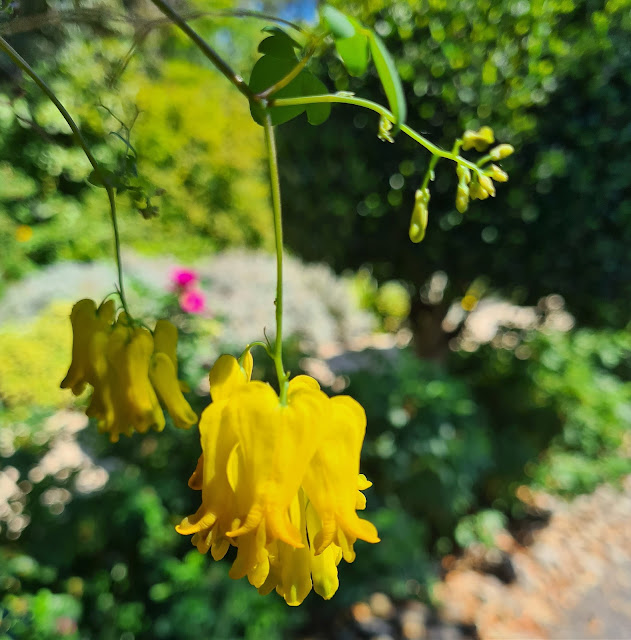Bleeding hearts and tears of pain
While we sat outside the cafe at Cloudehill Garden on a hot January morning, Lynda pointed out this intriguing yellow-flowered creeper behind my head. It was struggling a little, so I wondered if it was always a rather whispy, emphemeral kind of plant.
Seems not when it is in its element, a slightly cooler, wetter climate I suspect, such as UK gardens or its native home in the high-altitude forests of Asia, from India to China and northern Thailand. It's called Dactylicapnos scandens, or Yellow Bleeding Heart Vine, and we used to have one scrambling through the undergrowth in sheltered part of our Southern China Collection at Melbourne Gardens.
Sometimes you'll see this species included in Dicentra, a genus including other species also called 'Bleeding Heart' (and of course that common name is applied to other unrelated plants with leaves that are red on one side).
Both Dicentra and Dactylicapnos are in the family Papaveraceae, better known for the red (and other coloured) poppies. See my post on Shoes of the Virgin, for a truly intriguing member of this family growing on a Roman aqueduct in Spain!
This Yellow Bleeding Heart has a flower more like the Shoes of the Virgin, or the more common Fumatory (Fumaria), than it does a poppy. There are twelve species of Dactylicapnos, all with these intriguingly shaped flowers, like a heart symbol, but flared out at the base.
The plant climbs by attaching itself to other plants or structures with these fine tendrils, the kind of thing you might remember David Attenborough showing us in The Green Planet. There, with suitably spooky music, we saw time-lapsed climbers using tendrils to fight for existence in the rainforests of South America. Just looking at this next picture brings back those (post-production) squelching noises.
The flowers of this species are of course yellow, although there are variants which are pinkish or deep orange where the petals lobes reflex a little at the bottom of the pendent flower. In fact these may colour up more as they age - I can see a deeper yellow already in the lobes of some flowers.
Another name for this plant is Golden Tears Vine, giving the plant an even more sombre hue. Perhaps that's appropriate given its use over many centuries in Chinese medicine as a treatment for hypertension, inflammation, bleeding and various forms of pain.





Comments